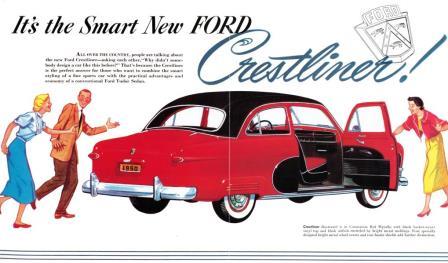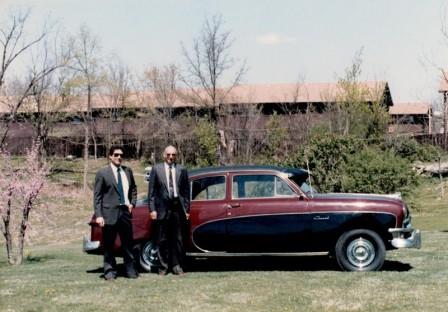Nettie Comes Home
By Ken Bounds
It was 1950. Chevy was beating Ford
in sales, partially because of its stylish new hardtop.
Ford planned to answer with a hardtop of its own, but the Victoria was
more than a year away. To try to
boost sagging sales, in May of 1950 Ford announced the Crestliner:
“Presenting the newest, brightest star of the highways!
It’s the smart new Ford Crestliner!”

The Crestliner was quite an eye catcher.
The exterior sported special spring colors with two-tone treatment –
Coronation Red Metallic and black or Sportsman Green and black, (Hawaiian Bronze
and brown came later) special side moldings creating what Ford called airfoils,
full vinyl roof, abundant stainless trim, unique full wheel covers, gold
anodized Crestliner fender insignia, stainless rocker moldings, dual outside
mirrors, and fender skirts. The
interior featured special leather/vinyl/Bedford cord seats and side panel
upholstery, vinyl headliner, full cut-pile carpeting, unique black 4-spoke
steering wheel with full horn ring, and Crestliner dash trim with two-tone paint
to match exterior.
In 1988, I went to visit my
parents for Easter in my home town of Kirksville, MO.
At the time, I had a 1950 Ford Business Coupe.
While in Kirksville I was visiting an old friend I grew up with, Richard
Ball. Richard mentioned to me that
he saw an old Ford for sale in town.
He thought it was a 1950 but wasn’t sure because it was a lot fancier than mine,
had a vinyl roof, and different chrome trim.
I was real surprised by this because it sure sounded like he was
describing a Crestliner. We jumped
in the car and went to have a look.
Sure enough, there it was: a red/black 1950 Ford Crestliner sitting on a used car lot. This car was a true “barn find”. All you had to do was open a door and you could smell the barn! The price on the “for sale” sign seemed a little high for the condition of the car, but there was a phone number so I decided to follow up when I got back home. It turned out that a local dealer was selling the car for the original owner, a retired cattle rancher from nearby Green Castle, MO, named Nettie Eitel.
Nettie was well known in
Northeast Missouri for raising prize-winning Angus cattle on her 700-acre ranch
outside Green Castle. Born in 1897,
Nettie never married and lived in the same place most of her life.
On August 31, 1950, Nettie traded in a 1939 Chevrolet for her last car -
a fancy new Ford Crestliner at the Kirksville Ford dealer.
The original Missouri title showed that the odometer had 340 miles on it.
I learned later that it was likely that the car would have been
driven from the Chicago assembly plant
to the dealership, thus accounting for the mileage.
 The
Crestliner did not have an easy life on the ranch.
I learned from talking to her nephew, her ranch foreman and a long-time
salesman from the Ford dealership that Nettie was pretty rough with the car and
was even known to drive it in her pasture herding cattle!
At some point she center-punched a tree or post, as evidenced by a
long-ago repair to the front end.
Nettie apparently liked pink cars long before Mary Kay did, as she had the red
on the Crestliner repainted bright pink early on.
As Nettie’s driving days came to an end, the Crestliner was parked in a
barn and was overtaken by various barn-dwellers, causing a lot of damage to the
interior and rusting of the rear portions of the floor and trunk.
The Crestliner had 55,718 miles on the odometer.
Annual inspection certificates and service records show this to be the
original miles.
The
Crestliner did not have an easy life on the ranch.
I learned from talking to her nephew, her ranch foreman and a long-time
salesman from the Ford dealership that Nettie was pretty rough with the car and
was even known to drive it in her pasture herding cattle!
At some point she center-punched a tree or post, as evidenced by a
long-ago repair to the front end.
Nettie apparently liked pink cars long before Mary Kay did, as she had the red
on the Crestliner repainted bright pink early on.
As Nettie’s driving days came to an end, the Crestliner was parked in a
barn and was overtaken by various barn-dwellers, causing a lot of damage to the
interior and rusting of the rear portions of the floor and trunk.
The Crestliner had 55,718 miles on the odometer.
Annual inspection certificates and service records show this to be the
original miles.
The story goes that some
smooth-talker came through town at one time and learned of the Crestliner.
Sight-unseen, he convinced Nettie’s family that the car could be worth
$10,000. The car was dragged out of
the barn and the pink was re-coated with a color thought to be close to the
original. It really wasn’t.
Nettie’s foreman then tried to sell the car, but when it was learned that
the car was worth nowhere near the alleged value, it was relegated back to the
barn. We never learned why, but in
the spring of 1988 the car was again put up for sale, this time at a much more
realistic price. After some
negotiating with Nettie’s agent, I purchased the Crestliner on April 20, 1988,
for $2,500. There were those at the
time who thought I got skinned.
Looking back, I don’t think so.
The car was not drivable, so my
dad worked with a local service station mechanic who was experienced with these
cars to go through it and get it ready for the road.
The engine was very tired, but with a new battery and two water pumps it
ran OK, if a little smoky. The
brakes were rusted to the drums, so those were rebuilt.
In June 1988 I went to Missouri and spent a lot of time with my dad
making the car presentable and cleaning up what the mice, bees, hornets, etc.
had left behind. June 25 was “coming
out day” when my dad drove the Crestliner, now affectionately called Old Nettie,
to a shoebox meet in Macon, MO. The
next day I drove Old Nettie from Missouri back home to Chicago where she had
been built 38 years earlier.
The Crestliner was certainly not
concourse quality, but it was a decent, quite original one-owner.
I decided to basically drive the car and enjoy it.
The wiring was a disaster; a patchwork of jumper wires had been added
just attempting to make everything work.
Early on I replaced the wiring in the car.
The interior was completely original, but was a mess from its rough
treatment and time in the barn, so I had some presentable seat covers installed.
Finally, the tired old V-8 was just burning too much oil, so I had it
rebuilt in 1992 by former NIRG member Don Roels.

Over the years I drove the
Crestliner to several shoebox meets and on many V-8 tours and showed it in
touring class at the 1993 Grand National in Dearborn and the 2001 Central
National Meet in Branson, where it took a 2nd Place trophy in Touring
Class. The car was always a lot of
fun, but the years and rough treatment were taking their toll.
The cheap paint that had been applied many years earlier was fading
badly, not to mention being a long way from the correct Coronation Red metallic.
The “bondoed” hood, a trunk lid that didn’t close properly, the wrong
vinyl roof and the shot interior were always there as reminders that the car had
seen better days. I often had
thoughts of restoration, but the parts unique to the Crestliner are scarce and
expensive and the interior and vinyl roof are not being reproduced.
Nevertheless, over quite a few years I began accumulating the Crestliner
parts that needed replacement: the
hard to find horn ring, the unique stainless side trim, the rare full wheel
covers, NOS stainless rocker moldings, etc.
In 2006 I bought an engine for my
1950 Convertible from a gentleman in Lockport named Everett Plata.
When I visited his shop while he was installing my engine, Everett showed
me the restoration work that he was doing on a 1951 Ford.
After a lot of discussion and seeing the quality of Everett’s work, I
decided that it was time to talk about restoration of Old Nettie.
We agreed on the work that needed to be done and in early February 2007 I
delivered Nettie to Everett.